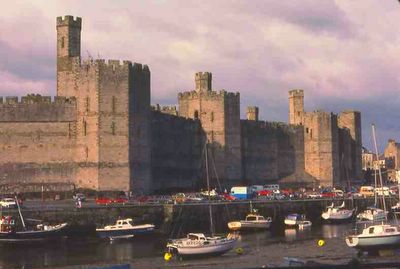
As I rode through Snowdonia, the rugged, mountainous piece of northwest Wales, a spectacular rain dropped from the sky and soaked men, sheep and mountains. Hikers ran for cover. Sheep stood stock still in their high, vertical pastures, and, looking like precision military units at attention, all faced the same direction, away from the worst bite of the whipping wind and water. Mountains that weren’t grass-covered and green were black, their wet slate slopes gleaming like polished onyx.
I was on my way to Caernarfon (Caernarvon) to see the country’s greatest castle (photo above). Wales is peppered with castles, brilliant and inspiring, and any one of them – Harlech, Pembroke, Conwy – would qualify for superlative status if they didn’t have to compete with Caernarfon.
As I drove through the rain, I saw a round castle keep on a hillside above the road. It was singularly beautiful, and I knew I had to explore it. I pulled off the road and looked at the storm clouds. They were moving fast, and I could see a clear patch sailing along behind them, so I sat in the car for the 15 minutes it took for the clouds to pass, then walked up the stony hill to the gray, graceful ruin. There was no sign at the site to tell me the name of this wonder I stood in. Not until I returned home and did some research did I learn it was Dolbadarn, built by Llywely the Great, Prince of Gwynedd, prior to the Edwardian conquest of Wales.
Many, I’m sure, in their haste to get to famed Caernarfon not far down the road, must miss or decide to miss this small castle keep. I recommend not missing it. Stand on Dolbadarn’s high hillock and take in the view of Snowdonia’s mountains and lakes and contemplate what must have gone on in the 13th century in this Welsh-built castle so close to where England’s Edward I would soon build Caernarfon, a mind-blowing castle – a conqueror’s castle— and a walled city that said to Wales, “We’re here to stay. This place is ours.” When Edward’s son was born in Caernarfon, he became the first Prince of Wales. Nearly three-quarters of a millenia later, Elizabeth II would use words first spoken in medieval times to introduce her son, Charles, to the public: "When he is grown up, I will present him to you at Caernarfon."
I’d seen a bright red and white sign near where I’d parked my car that advised, in Welsh and English, that it was lambing season. The sign was punctuated with exclamation points, driving home the fact that lambs ruled the roost until the season was over. A shepherd and his sheepdog came down from the Dolbadarn keep as I made my way up to it. They left, and I had the place to myself.
I picked my way over a sea of black slate chunks and explored the ruin. Then, time for Caernarfon. I got in my car and headed down out of Snowdonia, Eryri in Welsh. After five minutes, I smelled something pungent. After 10 minutes, I gave the smell some thought. What was this? Of course! It’s lambing season! It’s going to smell like sheep around here! I found it incredible that I could smell the lambing and the sheep and the pastures from inside my car, moving at 40 miles per hour with the windows rolled up.
I drove for a few more miles, then realized this wasn’t the sharp smell of Welsh farming and grazing pervading my vehicle. “LAMBING!!” on the bright red and white Dolbadarn sign had really been code for “Entering a Sheep Patty Minefield! Watch where you step!” The shepherd and sheepdog should have clued me. They weren’t at the hilltop castle to take in some culture or history. They’d been working. Those black slate chunks at Dolbadarn? Sheep doody. I had a literal crapload of sheep dip stuck on the bottom of my shoes.
When I got to Caernarfon, I sat in the site where 20-year-old Charles, Prince of Wales, delivered his 1969 investiture speech (in Welsh, after a crash course in the language at the University of Wales in Aberystwyth) and contemplated the powerful mass of the great castle while scraping what seemed like pounds of sheep chips from the soles of my favorite black traveling flats. These shoes had walked me around half the world, and I owed them a good cleaning. I’d scored a cache of slide film back in the Snowdonia resort town of Betws-y–Coed, and the Kodak boxes made fine manure removers.
Reasonably excrement-free, I walked the medieval walled town. Two boys swung on a tire over a muddy bulge in the River Seiont, and I asked if I could take their picture. “Where are you from?” they asked. When I told them I was from Boston and that I’d love to take a picture of two Caernarfon boys back to the US, they gave me the photo go-ahead and swung their tire out over the muck. As they swished by me, one leaned excitedly toward the other and said, “We might be in the newspaper!”
At the end of the day, I found the extraordinary Black Boy Inn, built in 1522. A labyrinth of half-timbered rooms and hallways, the place, hard by the medieval walls that surround Caernarfon, is a journey back in time. I was in awe as I checked in under ceiling beams so low they almost grazed my head. The owner laughed when I told her that where I come from, something 200 years old is considered remarkable, something to crow historically about. I must have smelled okay, because she gave me a primo room that overlooked 700-year-old ramparts.
Add Ribbons of Highway to your summer reading pile
Reviews and excerpts at LoriHein.com
